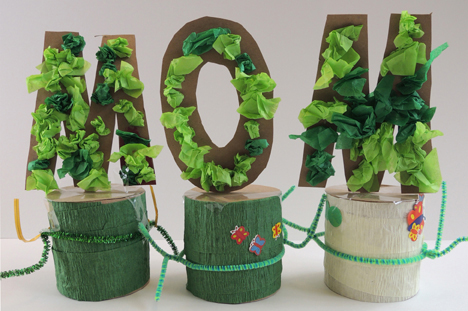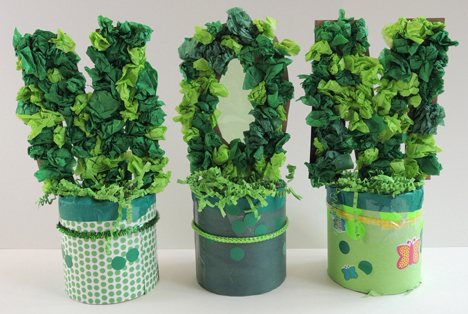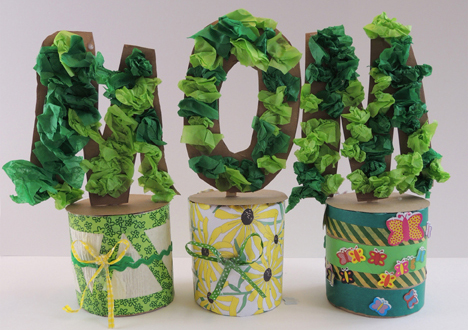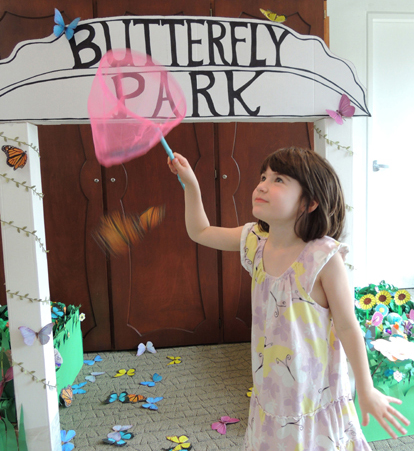 Bring your net and your sense of wonderment – there are butterflies in the park! We crafted a beautiful community garden, then waited for the butterflies to arrive. Swooping, diving, floating, and fluttering, how many butterflies can you catch for your own little garden?
Bring your net and your sense of wonderment – there are butterflies in the park! We crafted a beautiful community garden, then waited for the butterflies to arrive. Swooping, diving, floating, and fluttering, how many butterflies can you catch for your own little garden?
We read Butterfly Park by Elly MacKay (Running Press, 2015). A little girl moves from the country to the city, trading the sounds of birds and crickets for horns and trains. Her new house is right next to Butterfly Park – except that there are no trees, no flowers, and no butterflies in the park. Well, there is one butterfly, but it flies away. Undaunted, the little girl knocks on doors, recruiting neighborhood children to find butterflies to live in the park. Eventually, their search leads them to an important clue – flowers! Soon, the whole neighborhood is in Butterfly Park, planning, digging, and planting. Not only do butterflies come to live at the park, the little girl realizes that she’s found a home too.
You’ll need:
- 1 large tissue box
- 1 golf pencil
- Green pipe cleaners, sparkle stems, and/or drinking straws
- A selection of tissue paper
- A selection of crepe paper streamers
- A flower coloring template, printed on 8.5″ x 11″ card stock
- Green color masking tape
- Green construction paper
- Butterfly catching game (more on this later!)
- Scissors and tape for construction
- Markers for decorating
This story time project had three parts: 1) Making a little garden; 2) Putting all the little gardens together to make one big butterfly park; and 3) Catching butterflies in the park to take home in your little garden. We’ll begin with the little garden!
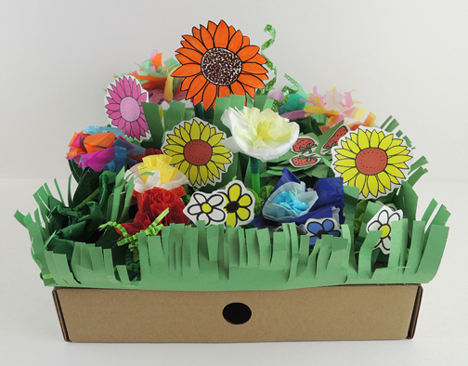 We used 9.5″ x 11″ cardboard trays rescued from the recycling bin. Flip the tray over and use a golf pencil to punch holes in the top (the golf pencils worked great with 3-5 year-olds and were much less scary than using scissors to poke holes).
We used 9.5″ x 11″ cardboard trays rescued from the recycling bin. Flip the tray over and use a golf pencil to punch holes in the top (the golf pencils worked great with 3-5 year-olds and were much less scary than using scissors to poke holes).
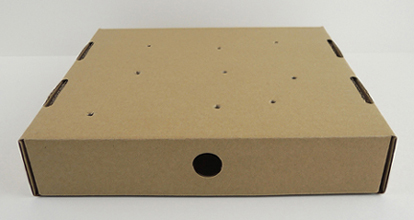 If you don’t have a tray, a large tissue box works too. Cut the top off the tissue box. Then, cut the entire box down to 2.5″. Flip it over, and use a golf pencil to punch holes in the top:
If you don’t have a tray, a large tissue box works too. Cut the top off the tissue box. Then, cut the entire box down to 2.5″. Flip it over, and use a golf pencil to punch holes in the top:
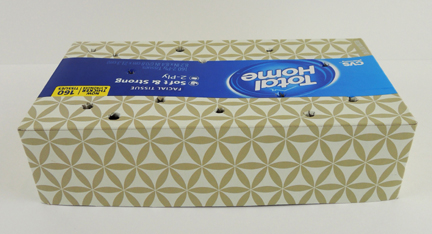 To plant your garden, cut a pipe cleaner, sparkle stem, and/or drinking straw in half. Attach a flower to one end, then poke the other end through a hole in the box. Secure the stem to the underside of the box with tape (or leave them loose so you can “pick” them!).
To plant your garden, cut a pipe cleaner, sparkle stem, and/or drinking straw in half. Attach a flower to one end, then poke the other end through a hole in the box. Secure the stem to the underside of the box with tape (or leave them loose so you can “pick” them!).
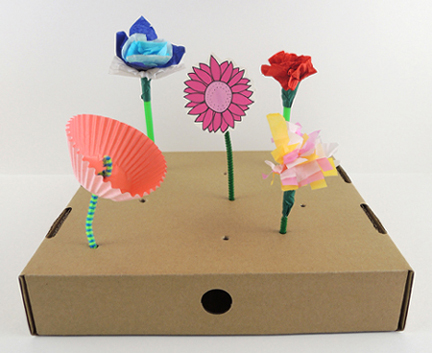 As you can see above, we offered tissue paper and baking cups for the flowers. You can also use the flowers from the template, and the kids can color them in. We brought out green construction paper grass fringes, green paper crinkles, and craft ties as well.
As you can see above, we offered tissue paper and baking cups for the flowers. You can also use the flowers from the template, and the kids can color them in. We brought out green construction paper grass fringes, green paper crinkles, and craft ties as well.
 When the decorating was done, the kids brought their little gardens to the BIG garden. The big garden consisted of a sign and 4 corner “hedges” we festooned with flowers. Kids placed their little gardens between the hedges, forming a perimeter in full bloom.
When the decorating was done, the kids brought their little gardens to the BIG garden. The big garden consisted of a sign and 4 corner “hedges” we festooned with flowers. Kids placed their little gardens between the hedges, forming a perimeter in full bloom.
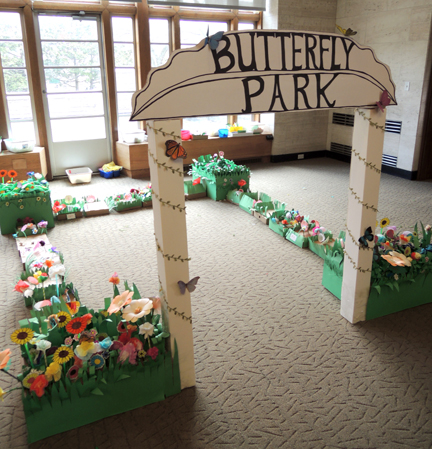
The hedges are recycled cardboard boxes. The sign is made of 3 recycled scroll boxes (2 as posts, one as the cross beam) and a piece of white cardboard. This garden is Marissa’s handiwork, right down to the beautiful hand-lettering on the sign. And check out her flower arranging skills!

The flowering garden is waiting, now for the butterflies! I found mine at Oriental Trading Company. Specifically, they’re from the the “Butterfly Hanging Door Curtain.” One curtain costs $6.50, and you get about 60 butterflies per curtain. The butterflies are sturdy tagboard, look realistic, and they’re printed double sided.
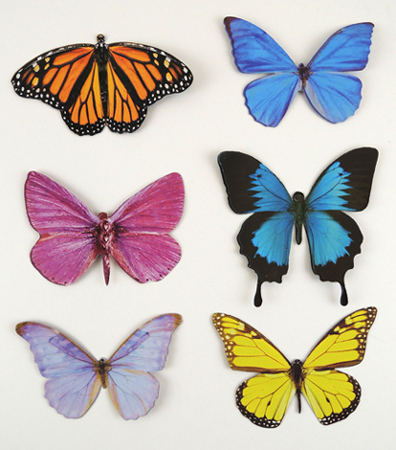 Four at a time, kids stepped into Butterfly Park wielding toy nets (I found mine in the $1 section of Target). Then Marissa and Joani strewed butterflies down upon them. Well, sometimes there was a little more dropping into nets than strewing…
Four at a time, kids stepped into Butterfly Park wielding toy nets (I found mine in the $1 section of Target). Then Marissa and Joani strewed butterflies down upon them. Well, sometimes there was a little more dropping into nets than strewing…
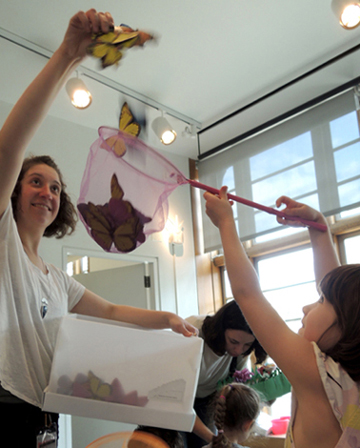 Once kids had caught some butterflies, they gently tucked them into their gardens to take home. Did they have fun? Yes they did! Some kids even stayed 20 minutes after story time ended, just to get in on some more butterfly catching fun!
Once kids had caught some butterflies, they gently tucked them into their gardens to take home. Did they have fun? Yes they did! Some kids even stayed 20 minutes after story time ended, just to get in on some more butterfly catching fun!
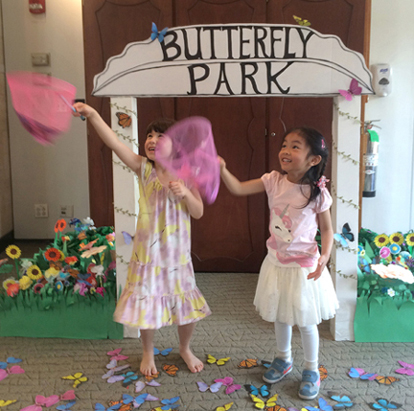

 Craft a castle packed with phytochemicals! Behold towers of corn, asparagus, and carrot. Admire the eggplant and pepper wall fortifications. Stride through the cucumber slice gates. Vegetables have never looked so noble!
Craft a castle packed with phytochemicals! Behold towers of corn, asparagus, and carrot. Admire the eggplant and pepper wall fortifications. Stride through the cucumber slice gates. Vegetables have never looked so noble!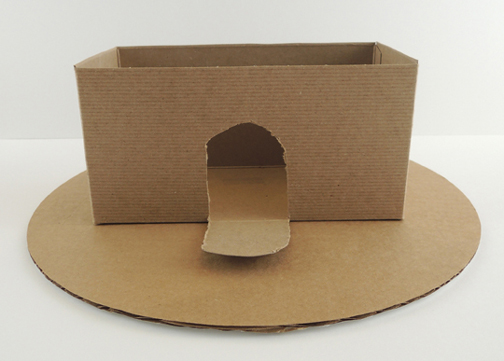 And now for the giant vegetables! Here they are, in no particular order.
And now for the giant vegetables! Here they are, in no particular order. We used a toilet paper tube, but if you want a taller stalk, cut a paper towel tube to the desired height. Wrap the tube with green construction paper. Cut 4 serrated leaves out of green construction paper, and tape (or hot glue) them close to the top of the tube. Pinch the tips of the leaves together, then secure them with tape or hot glue.
We used a toilet paper tube, but if you want a taller stalk, cut a paper towel tube to the desired height. Wrap the tube with green construction paper. Cut 4 serrated leaves out of green construction paper, and tape (or hot glue) them close to the top of the tube. Pinch the tips of the leaves together, then secure them with tape or hot glue. Cut a paper towel tube to the desired height, then wrap it with orange construction paper. Add a little green construction paper fringe to the top. Drawing black lines around the carrot are optional!
Cut a paper towel tube to the desired height, then wrap it with orange construction paper. Add a little green construction paper fringe to the top. Drawing black lines around the carrot are optional! Cut a paper towel tube to the desired height, then wrap it with green construction paper. Crumble up a piece of green tissue paper and hot glue it to the top of the tube. To make the broccoli’s “floretes,” crumble up 4 smaller pieces of tissue paper, then hot glue them to the tops of four, 1.5″ x 2.25″ pieces of green construction paper. Tape or hot glue the floretes close to the top of the tube.
Cut a paper towel tube to the desired height, then wrap it with green construction paper. Crumble up a piece of green tissue paper and hot glue it to the top of the tube. To make the broccoli’s “floretes,” crumble up 4 smaller pieces of tissue paper, then hot glue them to the tops of four, 1.5″ x 2.25″ pieces of green construction paper. Tape or hot glue the floretes close to the top of the tube. Cut a paper towel tube to the desired height, then wrap it with yellow paper. To make the corn’s “husk,” wrap a piece of green construction paper 3/4 of the way around the tube. Cut three points in the top of the green paper. Attach the husk with glue or tape, leaving the front of the corn exposed.
Cut a paper towel tube to the desired height, then wrap it with yellow paper. To make the corn’s “husk,” wrap a piece of green construction paper 3/4 of the way around the tube. Cut three points in the top of the green paper. Attach the husk with glue or tape, leaving the front of the corn exposed. Cut a paper towel tube to the desired height, then wrap it with green construction paper. We cut castle parapets in the top as well. Use a green marker to draw cucumber lines and bumps.
Cut a paper towel tube to the desired height, then wrap it with green construction paper. We cut castle parapets in the top as well. Use a green marker to draw cucumber lines and bumps.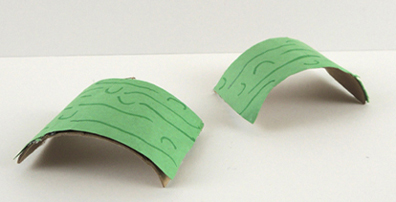 Cut a 1.5″ ring off the top of a toilet paper tube. Cut the ring in half and cover the tops of both sections with green construction paper. Use markers to draw cucumber lines and bumps.
Cut a 1.5″ ring off the top of a toilet paper tube. Cut the ring in half and cover the tops of both sections with green construction paper. Use markers to draw cucumber lines and bumps. Cut a toilet paper tube to the desired height, then wrap it with brown paper. To make the mushroom’s cap, crumble brown tissue paper and wrap another piece of tissue paper over the crumbles. Squish the tissue paper to make a cap shape, then hot glue the cap to the top of the tube.
Cut a toilet paper tube to the desired height, then wrap it with brown paper. To make the mushroom’s cap, crumble brown tissue paper and wrap another piece of tissue paper over the crumbles. Squish the tissue paper to make a cap shape, then hot glue the cap to the top of the tube.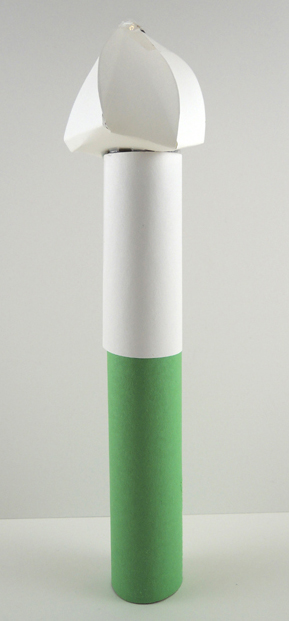 Cut a paper towel tube to the desired height, then wrap it with green construction paper. Next, wrap the top half of the tube with white paper. To make the bulb of the onion, cut the onion dome from the template. As you can see, it resembles a flower with multiple points. Fold each point inward toward the center of the template, then open it back up again.
Cut a paper towel tube to the desired height, then wrap it with green construction paper. Next, wrap the top half of the tube with white paper. To make the bulb of the onion, cut the onion dome from the template. As you can see, it resembles a flower with multiple points. Fold each point inward toward the center of the template, then open it back up again.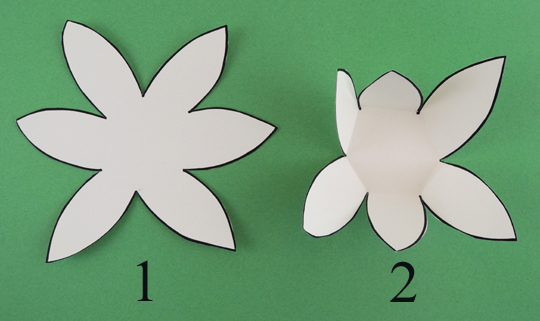 Gather two of the points over the center of the template and tape the tips together. Repeat with the remaining sets of points until you have 3 sets altogether.
Gather two of the points over the center of the template and tape the tips together. Repeat with the remaining sets of points until you have 3 sets altogether.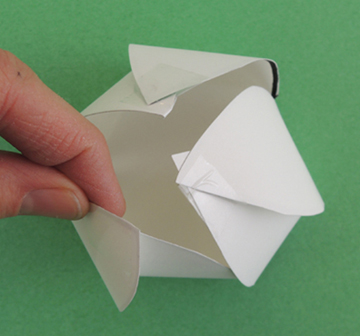 Gently push the 3 sets together over the center of the template, and tape together.
Gently push the 3 sets together over the center of the template, and tape together.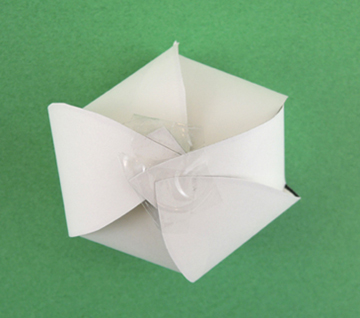
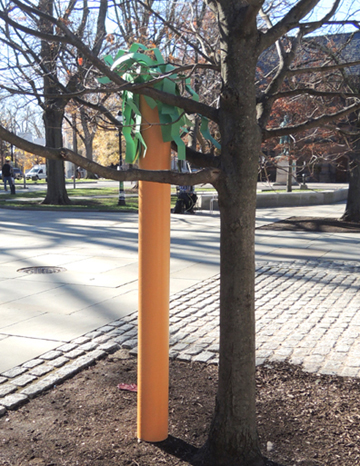
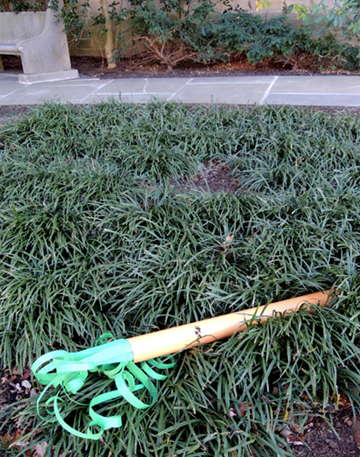
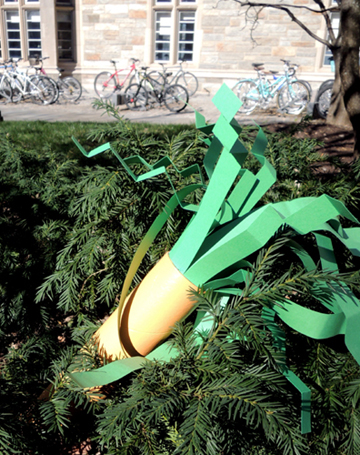 Carrot, frolicking amidst flowers…
Carrot, frolicking amidst flowers…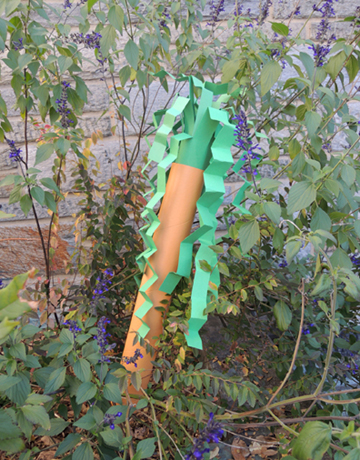
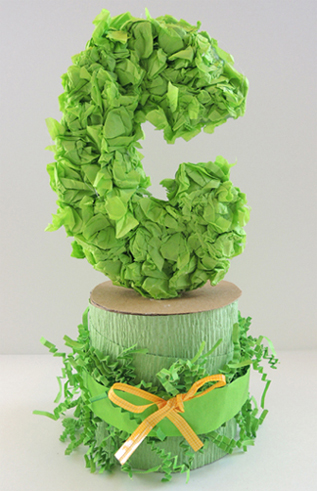 Spell something special with tissue paper topiary letters! Bedeck your initials, festoon your name, or spruce up your favorite word. Your personal topiary is guaranteed to stay green all year round, and no watering is required!
Spell something special with tissue paper topiary letters! Bedeck your initials, festoon your name, or spruce up your favorite word. Your personal topiary is guaranteed to stay green all year round, and no watering is required!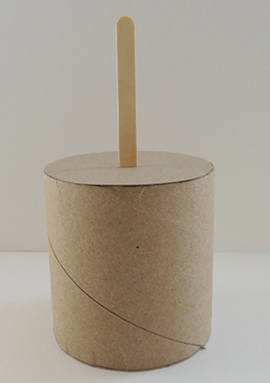 If you don’t have packing tape cores, use paper cups or paper soup containers. Simply flip them over, cut a slit in the bottom, and inset a craft stick into the slit.
If you don’t have packing tape cores, use paper cups or paper soup containers. Simply flip them over, cut a slit in the bottom, and inset a craft stick into the slit.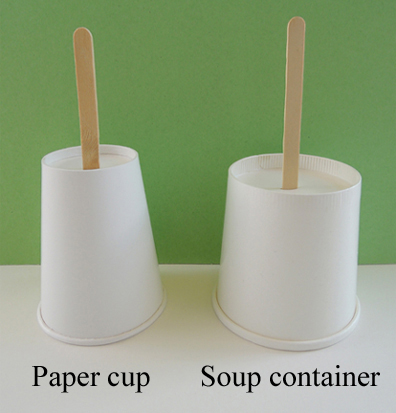 Since these bases are lighter than the tape cores, they run the risk of tipping over after you attach your topiary letters. If this happens, simply hot glue some pennies or
Since these bases are lighter than the tape cores, they run the risk of tipping over after you attach your topiary letters. If this happens, simply hot glue some pennies or  When the bases are finished, it’s time for your topiary letters! We asked the kids to limit themselves to 4 letters or less (and we announced this at the very beginning of the project, so they would know how many bases to decorate). After some experimentation, we determined that 6″ letters looked best. We whipped up some
When the bases are finished, it’s time for your topiary letters! We asked the kids to limit themselves to 4 letters or less (and we announced this at the very beginning of the project, so they would know how many bases to decorate). After some experimentation, we determined that 6″ letters looked best. We whipped up some 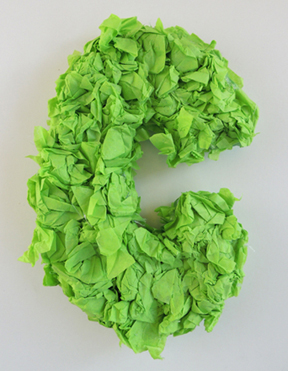 When the letter is done, hot glue it to the craft stick. Repeat until you have all your letters mounted on their bases:
When the letter is done, hot glue it to the craft stick. Repeat until you have all your letters mounted on their bases: You might wonder why we went with topiary letters instead of animals or objects. We did try a few animals and objects, but they became quite unrecognizable after the tissue paper was glued on. The letters held their shapes extremely well, and it never hurts to get an early start on letter recognition! Some topiary letters did go floppy from the glue, however. If this happens to you, simply use extra craft sticks to reinforce the back of the letter.
You might wonder why we went with topiary letters instead of animals or objects. We did try a few animals and objects, but they became quite unrecognizable after the tissue paper was glued on. The letters held their shapes extremely well, and it never hurts to get an early start on letter recognition! Some topiary letters did go floppy from the glue, however. If this happens to you, simply use extra craft sticks to reinforce the back of the letter.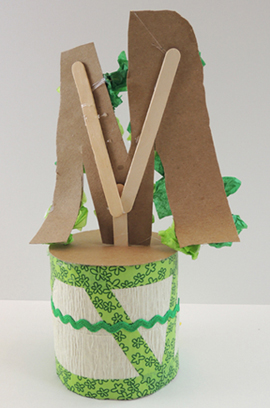 Another thing you can do to reduce floppiness? Use masking tape to secure the craft stick to the base. Here’s a shot of some tape stuck inside the base:
Another thing you can do to reduce floppiness? Use masking tape to secure the craft stick to the base. Here’s a shot of some tape stuck inside the base: Usually, our craft area is loud and boisterous during the projects. But for this particular project, the room was filled with quiet concentration as kids put their gardens together. Perhaps it was the soothing botanical colors?
Usually, our craft area is loud and boisterous during the projects. But for this particular project, the room was filled with quiet concentration as kids put their gardens together. Perhaps it was the soothing botanical colors?